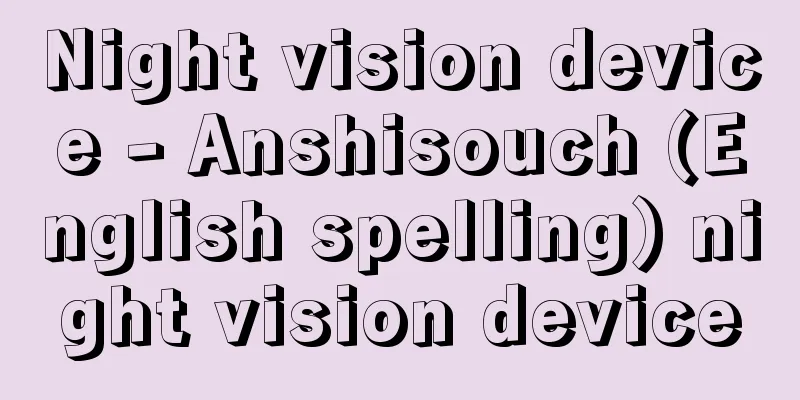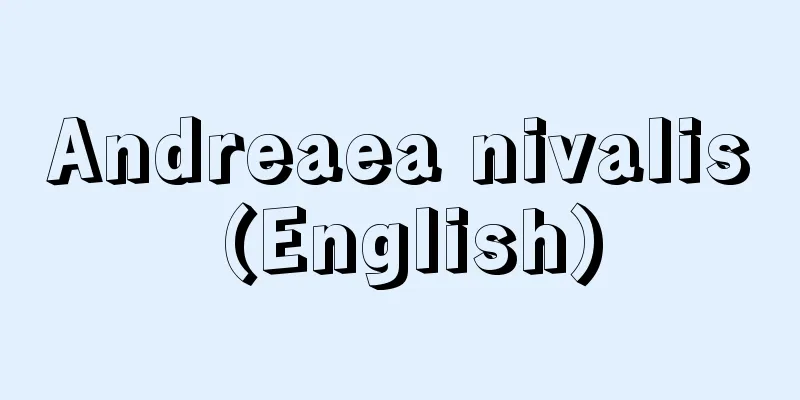Night vision device - Anshisouch (English spelling) night vision device

|
A device that displays objects or people in the dark or fog that cannot be seen directly by the human eye. Abbreviated as NVD. There are active and passive types. The active method is generally called noctovision. Its operating principle is that infrared light reflected from a subject illuminated with infrared light is received by an electron tube called an image tube (or night vision tube). The photocathode of the image tube emits photoelectrons according to the shade of the infrared image formed on it, so the infrared image is converted into changes in electron density. The converted electrons are then passed between electrodes that act as electron lenses, accelerated, and focused, and electrons with an energy of 15 to 20 kiloelectron volts hit the phosphor screen, causing it to emit light and providing a visible image. Because this device uses photoelectron emission, the delay time between the subject and the reproduced image is extremely short, and observations can be made with a good signal-to-noise ratio. It was developed for military purposes during World War II, but for general purposes it is used to capture religious ceremonies where normal lighting cannot be used, the nocturnal behavior of animals, and other things with television cameras, and is also used in infrared microscopes and thermometers. Note that noctovision was originally a product name, but has since become a generic name. Also, nocto means night in Latin. Passive night vision devices are generally called image intensifiers (abbreviated as II) or starlight scopes. Their operating principle is to receive and amplify faint visible and infrared light emitted by objects or people in the dark that cannot be seen by the naked eye using a highly sensitive photomultiplier tube (abbreviated as PMT). They can also amplify and see faint light from celestial bodies that cannot be seen by the naked eye. Since the 1960s, they have also been used for military purposes, including in the Vietnam War. The term image intensifier is applied to passive night vision devices to distinguish them from active night vision devices, but it is also used in a broad sense to refer to all night vision devices, including active night vision devices. As an example of the application of night vision devices, safe driving support devices for automobiles have also been developed. [Akiyoshiro Yoshikawa] [Reference item] |©Shogakukan "> Structure and principle of NoctVision Source: Shogakukan Encyclopedia Nipponica About Encyclopedia Nipponica Information | Legend |
|
人の目で直接見ることができない暗夜や霧の中の物体や人物などを映し出す装置。略称NVD。アクティブ方式とパッシブ方式とがある。 アクティブ方式は一般にノクトビジョンnoctovisionとよばれる。その動作原理は、赤外線を当てた被写体から反射してきた赤外線をイメージ管(または暗視管)とよばれる電子管で受ける。イメージ管の光電面はその上に結んだ赤外線像の濃淡に応じて光電子を放出するので、赤外線の像は電子の密度変化に変換される。そこで、変換された電子を電子レンズの作用をする電極の間を通過させ、加速、集束させると、15~20キロ電子ボルトのエネルギーをもった電子が蛍光面に当たり、蛍光面を発光させて目に見える像が得られる、というものである。この装置は光電子放出を利用しているため、被写体と再現される像の間の遅延時間がきわめて短く、しかも良好な信号対雑音比で観測をすることができる。第二次世界大戦中、軍事目的に開発されたが、一般の目的では、通常の照明を当てられない神事や、動物の夜の生態などをテレビカメラでとらえるのに利用され、さらに赤外線顕微鏡や温度計などにも利用されている。なお、ノクトビジョンは本来商品名であったものが一般名化したものである。また、noctoはラテン語で夜の意味である。 パッシブ方式は一般にイメージインテンシファイアimage intensifier(略称I.I.(アイアイ))、あるいはスターライトスコープstarlight scopeなどとよばれる。その動作原理は、肉眼では認識することができない暗闇(くらやみ)中の物体や人物などから出るわずかな可視光や赤外線を高感度の光電子増倍管photomultiplier(略称ホトマル、またはPMT)で受けて増幅し、可視化するものである。肉眼では見ることのできない天体からの微少な光を増幅して見ることも可能である。1960年代からは軍事目的にも利用され、ベトナム戦争で使われた。イメージインテンシファイアの名は、アクティブ方式と区別してパッシブ方式の暗視装置に適用されるが、広義にはアクティブ方式も含めた暗視装置全般をさすのに使われることもある。 なお、暗視装置の応用例として、自動車の安全運転支援装置も開発されている。 [吉川昭吉郎] [参照項目] |©Shogakukan"> ノクトビジョンの構造と原理 出典 小学館 日本大百科全書(ニッポニカ)日本大百科全書(ニッポニカ)について 情報 | 凡例 |
>>: The Spring and Autumn of Yanzi
Recommend
The Triumph of Death (English: Trionfo della Morte)
A full-length novel by Italian author D'Annun...
Sophokles - Sophocles
Along with Aeschylus and Euripides, he is one of ...
Island Arc - Touko
An archipelago that forms an archipelago like a bo...
Waters, M.
...guitar), Robert Johnson (1912?-38, guitar), a ...
Quarantine - Boueki
Quarantine was originally a synonym for the preve...
Optical glass - kougakugarasu (English spelling) optical glass
Glass is a highly homogeneous material used in op...
Cape Awazaki
…It is a small plateau-like island measuring 2km ...
Yoshimaro Yamashina
Ornithologist. Born as the second son of Prince Y...
Chemical prevention - KAGAKUYOBO
…However, chemotherapy is now being attempted for...
Water disease - Shuǐ bìng (English spelling)
The name of a disease in Chinese medicine. Water i...
Appetite - Food
Along with thirst and sleep, hunger is an innate,...
Cotoneaster
…There are several species of the Pyracantha genu...
Palmiro Togliatti
1893-1964 Leader of the Italian Communist Party. H...
Atropine
A type of alkaloid found in plants of the Solanac...
Cold index
…In addition, there is a belief that frost resist...









